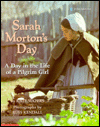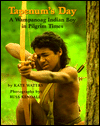Sarah Morton's Day, Samuel Eaton's Day, and Tapenum's Day
by Kate WatersIn Kate Waters' books, she shows young readers (through photographs and text) about the lives of a Pilgrim girl, a Pilgrim boy, and a Wampanoag Indian boy. These books include: Sarah Morton's Day: A Day in the Life of a Pilgrim Girl, Samuel Eaton's Day: A Day in the Life of a Pilgrim Boy, and Tapenum's Day: A Wampanoag Indian Boy in Pilgrim Times.
 |  |  |
Enrichment Activities
Internet Resources
Books
Enrichment Activities
Compare and ContrastAt the beginning of the activity, give students pieces of paper and ask them to jot down any differences or similarities they notice in the lives of the three children in the books. Read aloud Sarah Morton's Day, Samuel Eaton's Day, and Tapenum's Day – one right after another. Provide copies of the books for students to examine in detail. Conduct a class discussion and analyze the comparisons students discovered.
Make a Book About Modern Life
Since Kate Waters recaptures life in Colonial times in great detail and makes it vivid through pictures, why not capture modern life in the same way? Ask students to brainstorm a list of activities that typically take place during their day. Assign each child one of the activities to act out and ask them to bring in any props they might need. On a designated day, tell the students to bring in all of their props and take photographs of each child in action. Once the pictures are developed, ask each student to write a paragraph describing the picture and indicating why that activity is significant in today's society. After the paragraphs have been edited, ask students to paste their photos onto a sheet of colored construction paper, leaving at least a two-inch border on the bottom of the page. Once the photograph is in place, write or attach the edited version of the caption underneath the photo. Bind all of the pages together with yarn or metal clips and you'll have a book about modern life!
Play a Guessing Game
Sharpen students' critical thinking skills by playing a guessing game. Ask students to sit on the floor and place a chair in front of them. Choose one student to lead the game and tell her to sit in the chair. Give her a moment to peruse the books and select one of the photographs. The leader should then silently select an object or action (such as milking a cow) from the photograph. When she is ready to begin the game, she turns to the group, shows them the photograph, says "I'm thinking of..." and adds a generally descriptive phrase to the end of this sentence. For example, the leader might say "I am thinking of something that has to be done every day" as a way to describe milking the cow. The rest of the students are allowed to ask only yes or no questions to which the leader can respond with hot (for yes), cold (for no), or warm (for a guess that is close, but not entirely accurate). The game continues until one of the students guesses correctly. That student becomes the new leader and you begin the game anew.
Explore Family Traditions
Many families have their own idiosyncratic traditions that they follow each Thanksgiving. Define tradition for the students and ask them to share traditions practiced by their own families. Here's a story you might want to share with students to set the mood:
- My friend Kathy always cooked her turkey in a roasting pan and put the legs and wings in a separate pan to cook. Each year her turkey was delicious, if a bit funny looking. One year, as the family gathered around the table, a guest had the nerve to ask why she cooked the turkey this way. Kathy replied,"Well, Mom always did it that way, so I learned it from her." Kathy's mother smiled and said she'd learned it from watching her mother cook turkeys when she was a little girl. When she heard all of this, Kathy's Grandma laughed out loud and said, "I cooked the turkey that way because my oven was too small for the turkey to fit any other way!"
Do a Food Experiment
Have students research the type of food the Pilgrims brought on the Mayflower (use the Plimoth Plantation Website) and ask students why the Pilgrims selected those foods. Do an experiment to allow your students to discover why the Pilgrims did not take along highly perishable items. Give each student several sheets of white paper. Allow students to choose any food they wish and leave it out, unrefrigerated, for a week. Make sure that the items are in tightly covered containers. The first day students should write a hypothesis about their food item: What do they think will happen by the end of the week? Underneath the hypothesis each student should draw the food item and write the date next to it. Each day, students should draw and describe the way the food item changes. At the end of the week, conduct a discussion about which foods decayed faster, why that might be, and ask students what they would take with them if they had to experience a journey similar to that of the Mayflower's.
Amuse Yourself on the Mayflower
In another Kate Waters' book, On the Mayflower: Voyage of the Ship's Apprentice and a Passenger Girl, the hardships of life on board ship are described in detail. Often passengers did not have enough to eat, there was almost no privacy, and many people became sick and died. It took 66 days for the Mayflower to cross the Atlantic. Ask students to read the book and then imagine that they are children aboard the Mayflower. Have students write journal entries from the point of view of a passenger on the ship. Ask students to consider what kinds of games they would have made up to amuse themselves, and what emotions the passengers must have felt from the beginning of the journey until they saw land again. As an extension of the journal writing, break students into small groups and ask them to create a simple game that requires few materials beyond their imagination. Once each group has created a game and written down the instructions, ask them to teach it to the rest of the class. When all the games have been explained, allow the students to try each other's creations.






